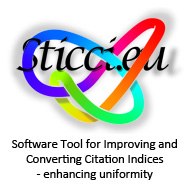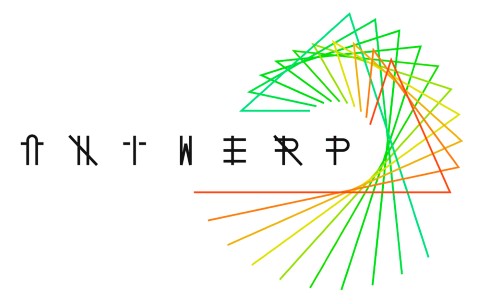Tensegrity from Scopus &
Web of Science during 2012-2013
In the next links it is possible to find very important information about all the papers and publications gathered in the databases Scopus and Web of Science during the years 2012 and 2013. The data entries are referred not only to the areas of engineering, computing sciences, mathematics and physics, but also to the fields related to health and human sciences.
Note that some references are duplicated, to show actually that they can be found in both Scopus and Web of Science databases. All information is available at the following links:
"Mallas tensegríticas de doble capa y manipulaciones de Rot-Umbela"
New paper about Tensegrity on "Informes de la Construcción". Recently, a new paper about Tensegrity has been published on Informes de la Construcción: "Mallas tensegríticas de doble capa y manipulaciones de Rot-Umbela", by Gómez-Jáuregui, available in Open-access in the electronic version of that journal.
Special issue on Tensegrity in the International Journal of Space Structures
Special issue on Tensegrity in the International Journal of Space Structures. This month of June a double issue focused on Tensegrity has apperared, gathering papers presented recently in the Structural Engineeres World Congress 2011. Really interesting.
Editorial
Author: R. Motro
v-vi
Forewords
Author: Gian Carlo Giuliani, Guest Editor
iii-iv
The Art of Tensegrity
Author: Kenneth Snelson
71-80
Design Aspects of a Deployable Tensegrity-Hollow-rope Footbridge
Authors: L. Rhode-Barbarigos, N. Bel Hadj Ali, R. Motro and I. F. C. Smith
81-96
Interactive Dynamic Design and Analysis of Tensegrity Systems
Authors: Julien Averseng, Jérome Quirant and Jean-François Dubé
97-106
Mechanical Behaviour in Axial Compression of a Tensegrity Ring: Parametric Study and Rheological Model
Authors: Cévaër Franck, Quirant Jérôme and Dubé Jean-François
107-116
Improving Bending Stiffness of Tensegrity Booms
Authors: Seif Dalilsafaei, Anders Eriksson and Gunnar Tibert
117-130
Tensile Tensegrity Structures
Authors: Robert E Skelton and Kenji Nagase
131-138
Design and Analysis of Tensegrity Power Lines
Authors: Seif Dalilsafaei and Gunnar Tibert
139-154
Novel Technique for Obtaining Double-Layer Tensegrity Grids
Authors: Valentín Gómez-Jáuregui, Rubén Arias, César Otero and Cristina Manchado
155-166
Structural Performances of Single-layer Tensegrity Domes
Authors: Davide Cadoni and Andrea Micheletti
167-178
Debunking "Tensegrity" - A Personal Perspective
Author: Ariel Hanaor
179-184
Books about Tensegrity in Amazon
Books about Tensegrity in Amazon. Already available the books published by the "Universidad de Cantabria" in Amazon web page, not only in Spanish (Spain) but also in English (websites from UK and USA).
Tensegrity from Scopus &
Web of Knowledge during 2011
In the next link it is possible to find very important information about all the papers and publications gathered in the databases Scopus and Web of Knowledge during the last year 2011. The data entries are referred mainly to the areas of engineering, computing sciences, mathematics and physics, not including the fields related to health and human sciences due to it is not the main objective of this web page.
Note that some references are duplicated, to show actually that they can be found in both Scopus and Web of Knowledge databases. All information is available at the following link:
Publications about Tensegrity from Scopus and Web of Knowledge 2011
Publications in Scribd
There is a new collection of documents in Scribd, all of them related to Tensegrity. The number of publications gathered in Scribd is already important, but it is increasing constantly thanks to the apportations of many users.
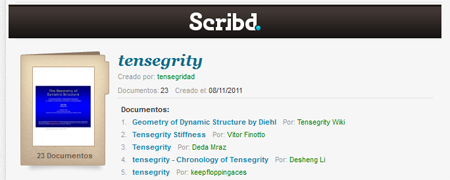
For all the people who don't know what is it about, Scribd is a Web 2.0 based document-sharing website which allows users to post documents of various formats, and embed them into a web page using its iPaper format.
Original Tensegrity Patents
Three men have been considered the inventors of Tensegrity: Richard Buckminster Fuller, David Georges Emmerich and Kenneth D. Snelson. As a precaution, these names have been mentioned in chronological order of their granted patents: Fuller-13 Nov 1962; Emmerich-28 Sep 1964; Snelson-16 Feb 1965.
In which follows, it is possible to access to the original documents of their patents, in order to check their original work and innovative proposals.
Richard Buckminster Fuller:
"Tensile-Integrity Structures". U.S. Patent No. 3,063,521. 13 Nov 1962
"Suspension Building" (also called aspension). U.S. Patent No. 3,139,957. 7 Jul 1964
"Non-symmetrical Tension-Integrity Structures". U.S. Patent No. 3,866,366. 18 Feb 1975
David George Emmerich:
"Construction de Reseaux Autotendants", French Patent No. 1,377,290. 28 Sep 1964
"Structures Linéaires Autotendants", French Patent No. 1,377,291. 28 Sep 1964
Kenneth Snelson:
"Continuous Tension, Discontinuous Compression Structure". U.S. Patent No. 3,169,611. 6 Feb 1965
Search in Google Scholar
A new search bar is included to find directly in Google Scholar publications about tensegrity and similar concepts. Have a nice search!
Tensegrity on Scopus &
Web of Knowledge since 2010
In order to complete the references on Tensegrity appeared in the database Web of Knowledge, the bibliography has been updated to include all the publications referred to Tensegrity in the engineering field that have been published in other database: Scopus.
Note that some references are duplicated, to show actually that they can be found in both Scopus and Web of Knowledge databases. All information is available at the following link:
References about Tensegrity from Scopus and Web of Knowledge
Publications about Tensegrity
from Web of Knowledge in 2010
In the next link you can find very important information about all the papers and publications gathered in Web of Knowledge in 2010:
Bibliographic References from
Web of Knowledge
In the Data Base of Web of Knowledge there is a huge amount of information about Tensegrity. As it could be useful for some people, a selection of all the engineering records (apart from the related to biological or anatomical subjects) is posted here. It is an Excel file (format 2007) with all the information related to Author, Title, Type of Publication, DIO, number of Pages and so more, including an Abstact if availabel. The fact of being organized with filters is really useful.
You can find it in the following link: Search_Tensegrity-Bio_in_WoK_101025
You can find some more informations in the official web page: http://wokinfo.com/
Tensegrity Structures and their Application to Architecture
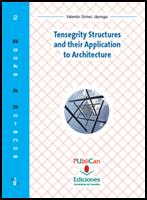
El número dos de la colección “Books&Science” es Tensegrity Structures and their Application to Architecture, una gran aportación del ingeniero civil Valentín Gómez Jáuregui.
Titulado por la UC en la ETS de Ingenieros de Caminos, Canales y Puertos, el autor propone en su texto, fiel a la tesis del Máster de Arquitectura en la que investigó sobre este campo, un acercamiento a las estructuras tensigríticas, que define como “realmente intrigantes”: barras flotando en el aire sin contacto con un soporte sólido o unidas por un solo cable a otras barras…
Este libro de 296 páginas explica el origen de estas estructuras atípicas y los principios físicos que permiten su existencia, además de analizar sus ventajas, desventajas y aplicaciones en campos como la arquitectura y la ingeniería.
Tensegridad. Estructuras Tensegríticas en Ciencia y Arte
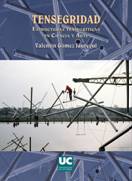
Las estructuras tensegríticas son realmente asombrosas: constan de barras que están flotando en el aire, tan sólo sujetas mediante cables a otras barras... ¡que también flotan en el aire!
Quizás sea precisamente esto lo que a la gente le entusiasma de la Tensegridad, contemplar este fenómeno "mágico" que son incapaces de entender.
La presente obra sirve de introducción a estos sistemas de “compresión flotante”: indaga en su controvertido origen y autoría, profundiza en sus fundamentos físicos y estructurales, clasifica y ordena los diferentes tipos de tensegridades, analiza su presencia en la naturaleza, la ciencia y el arte y finalmente aborda sus actuales y futuras aplicaciones en ingeniería y arquitectura. En definitiva, pretende ser una guía que oriente en este nuevo mundo que se abre camino.
